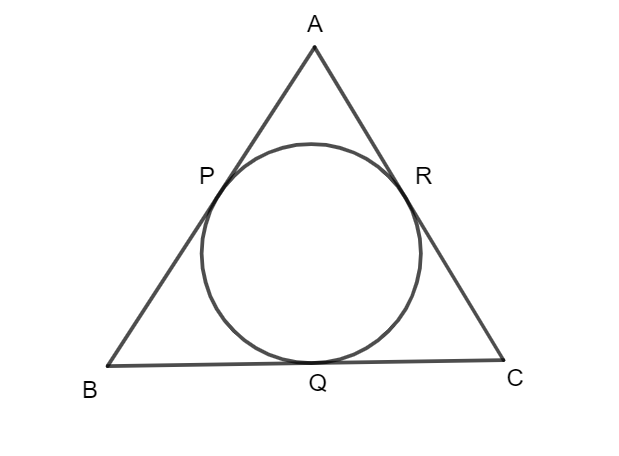
If the incircle of $\Delta ABC$ touches the sides AB, BC and CA at P, Q and R, find the value of: AP + BQ + CR
A. $AB+BC+CA$
B. \[2\left( AB+BC+CA \right)\]
C. \[\dfrac{1}{2}\left( AB+BC+CA \right)\]
D. \[AB-BC-CA\]
Answer
509.1k+ views
Hint: We solve this question by drawing a diagram for the above question which consists of a circle inscribing a triangle. Then, we use the concept of tangents drawn to a circle which says tangents drawn from an external point to a circle are equal. Using this, we find the value of the expression $AP+BQ+CR.$
Complete step by step answer:
In order to solve this question, let us draw a figure for the given question. This is as shown in the figure below.

We can see a triangle ABC with a circle inscribed in it touching the sides AB, BC and CA at P, Q and R respectively. We now know the concept that the tangents drawn from an external point to a circle are equal. This means that the tangents drawn to the circle from the point A which are AP and AR are equal. Similarly, the tangents drawn from the point B to the circle which are BP and BQ are equal. Similarly, for the third point C, the two tangents drawn from the point to the circle which are CQ and CR are equal.
This can be represented as,
$\Rightarrow AP=AR\ldots \left( 1 \right)$
$\Rightarrow BQ=BP\ldots \left( 2 \right)$
$\Rightarrow CR=CQ\ldots \left( 3 \right)$
Let us now add all the three equations,
$\Rightarrow AP+BQ+CR=AR+BP+CQ\ldots \left( 4 \right)$
We know that the perimeter of the triangle is given by,
$\Rightarrow Perimeter=AB+BC+CA\ldots \left( 5 \right)$
AB can be written as AP + BP, BC can be written as BQ + CQ and CA can be written as CR + AR.
$\Rightarrow Perimeter=AP+BP+BQ+CQ+CR+AR$
Taking the terms AP, BQ and CR together,
$\Rightarrow Perimeter=AP+BQ+CR+AR+BP+CQ$
From equation 4 we replace the last 3 terms of the above equation.
$\Rightarrow Perimeter=AP+BQ+CR+AP+BQ+CR$
Adding the same terms twice and taking the 2 common out,
$\Rightarrow Perimeter=2\left( AP+BQ+CR \right)$
From equation 5, we replace the left-hand side of the perimeter.
$\Rightarrow AB+BC+CA=2\left( AP+BQ+CR \right)$
Dividing both sides of the equation by 2,
$\Rightarrow \dfrac{1}{2}\left( AB+BC+CA \right)=AP+BQ+CR$
So, the correct answer is “Option C”.
Note: We need to know the concept of tangents to a circle in order to solve such problems. We need to be careful and note that in AB, AP and BP need not be of the same length. They can be of different lengths depending on the tangents. The intersection of these tangents form the corners of the triangle.
Complete step by step answer:
In order to solve this question, let us draw a figure for the given question. This is as shown in the figure below.

We can see a triangle ABC with a circle inscribed in it touching the sides AB, BC and CA at P, Q and R respectively. We now know the concept that the tangents drawn from an external point to a circle are equal. This means that the tangents drawn to the circle from the point A which are AP and AR are equal. Similarly, the tangents drawn from the point B to the circle which are BP and BQ are equal. Similarly, for the third point C, the two tangents drawn from the point to the circle which are CQ and CR are equal.
This can be represented as,
$\Rightarrow AP=AR\ldots \left( 1 \right)$
$\Rightarrow BQ=BP\ldots \left( 2 \right)$
$\Rightarrow CR=CQ\ldots \left( 3 \right)$
Let us now add all the three equations,
$\Rightarrow AP+BQ+CR=AR+BP+CQ\ldots \left( 4 \right)$
We know that the perimeter of the triangle is given by,
$\Rightarrow Perimeter=AB+BC+CA\ldots \left( 5 \right)$
AB can be written as AP + BP, BC can be written as BQ + CQ and CA can be written as CR + AR.
$\Rightarrow Perimeter=AP+BP+BQ+CQ+CR+AR$
Taking the terms AP, BQ and CR together,
$\Rightarrow Perimeter=AP+BQ+CR+AR+BP+CQ$
From equation 4 we replace the last 3 terms of the above equation.
$\Rightarrow Perimeter=AP+BQ+CR+AP+BQ+CR$
Adding the same terms twice and taking the 2 common out,
$\Rightarrow Perimeter=2\left( AP+BQ+CR \right)$
From equation 5, we replace the left-hand side of the perimeter.
$\Rightarrow AB+BC+CA=2\left( AP+BQ+CR \right)$
Dividing both sides of the equation by 2,
$\Rightarrow \dfrac{1}{2}\left( AB+BC+CA \right)=AP+BQ+CR$
So, the correct answer is “Option C”.
Note: We need to know the concept of tangents to a circle in order to solve such problems. We need to be careful and note that in AB, AP and BP need not be of the same length. They can be of different lengths depending on the tangents. The intersection of these tangents form the corners of the triangle.
Recently Updated Pages
Master Class 10 General Knowledge: Engaging Questions & Answers for Success

Master Class 10 Computer Science: Engaging Questions & Answers for Success

Master Class 10 English: Engaging Questions & Answers for Success

Master Class 10 Social Science: Engaging Questions & Answers for Success

Master Class 10 Maths: Engaging Questions & Answers for Success

Master Class 10 Science: Engaging Questions & Answers for Success

Trending doubts
The shortest day of the year in India

Why is there a time difference of about 5 hours between class 10 social science CBSE

Write a letter to the principal requesting him to grant class 10 english CBSE

What is the median of the first 10 natural numbers class 10 maths CBSE

The Equation xxx + 2 is Satisfied when x is Equal to Class 10 Maths

State and prove converse of BPT Basic Proportionality class 10 maths CBSE




